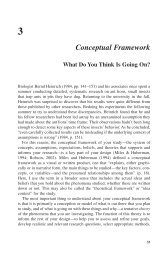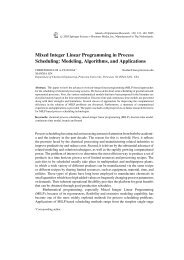Qualitative Research Basics: A Guide for Engineering Educators
Qualitative Research Basics: A Guide for Engineering Educators
Qualitative Research Basics: A Guide for Engineering Educators
You also want an ePaper? Increase the reach of your titles
YUMPU automatically turns print PDFs into web optimized ePapers that Google loves.
Grounded Theory<br />
Grounded theory is an approach to qualitative data that aims to develop theory that is<br />
“grounded” in data. Grounded theory was first described by Glaser and Strauss in 1967,<br />
and has since been refined and expanded. It was originally developed in reaction to the<br />
trend within sociology to propose theories and then test them (Creswell, 2007). In<br />
contrast, Glaser and Strauss emphasized the development of theory based on empirical<br />
data. The approach is inductive rather than deductive.<br />
Grounded theory is primarily a data analysis technique, and details of the data analysis<br />
are covered in Chapter 6. Some of the key attributes of a grounded theory study are:<br />
• Data collection and analysis occur simultaneously. As analysis occurs, missing<br />
elements are identified, which become targets <strong>for</strong> further data collection.<br />
• Data analysis proceeds through the constant comparative method, in which<br />
interview statements are coded, categorized, and grouped to develop a theory.<br />
• Data collection proceeds until the categories are “saturated,” that is, until no new<br />
in<strong>for</strong>mation is obtained with further data collection.<br />
• The theory developed is not necessarily high level theory. It is often what<br />
Creswell calls a “substantive-level theory,” which applies to the specific setting or<br />
context in which the data was collected.<br />
Some authors, Charmaz (2006) in particular, argue that classic grounded theory is<br />
positivist in its theoretical perspective. This is seen in the original description of<br />
grounded theory that implies that the data are discovered by the researcher and are<br />
“untouched by the competent researcher’s interpretations” (Charmaz, 2006, p. 132). In<br />
contrast, Charmaz advocates a more flexible view of grounded theory. In her view of<br />
constructivist grounded theory, the researcher’s perspective becomes part of the data<br />
analysis and interpretation. There are no objective data waiting to be discovered; rather<br />
data and analysis are, “created from shared experiences and relationships with<br />
participants and other sources of data” (p. 130). Further, “the theory depends on the<br />
researcher’s view; it does not and cannot stand outside of it” (p. 130, italics in original).<br />
Charmaz’s view moves grounded theory closer to the interpretivist perspective than<br />
classic descriptions.<br />
Case Study<br />
A case study is characterized by in-depth study of a bounded system. The boundaries of<br />
the case may be defined in terms of time, space, or participants (Merriam, 2002). For<br />
example, a case may be a classroom, a particular event, or an organization. A case study<br />
is selected when one wants to study a specific situation (the case) in depth. Within this<br />
broad definition of a case study, there are many possible approaches that can be taken,<br />
depending on the overall purpose of the study. For example, Stake (2005) identifies three<br />
different types of case studies. The intrinsic case study has as its focus an in-depth<br />
understanding of that particular case. The case is not chosen because it is representative<br />
of a more general phenomenon, but simply because it is interesting in and of itself. The<br />
instrumental case study is chosen to provide insight into a more general phenomenon.<br />
12
















